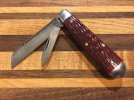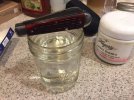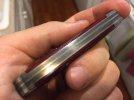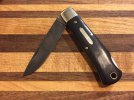- Joined
- Jul 19, 2014
- Messages
- 2,199
The BladeForums.com 2024 Traditional Knife is available! Price is $250 ea (shipped within CONUS).
Order here: https://www.bladeforums.com/help/2024-traditional/
Say for instance I received a knife with a mustard patina I don't like. Would I be able to use this process without removing the old patina?
Would that happen to be a 73?Just wipe it good with alcohol to de-grease and it will just get as dark as you want it.




Cool thread - I had heard of these forced patina but did not know this is how people were getting these super smooth and even patinas.
Like some have mentioned, once you start using your knife (assuming you do use your knife) and cut some food, that patina constantly changes. Heck, just opening and closing it changes the patina on some of my knives (maybe from oil on my fingers?).
I'd think tying to maintain an even patina is harder than preventing it from happening? Unless you use some of the tricks mentioned in this thread on a regular basis.
Yes it changes daily depending on use and exposure. For example if it's been a hot summer day and the knife has been in my front pocket. The sweat exposure makes dramatic changes even to the bolsters. It wears off again within a day or so as it evolves daily. I just let it age and change as it will.
It has no effect on the usefulness of the knife.




I tried this a while back, but after a bit of carry, I noticed that the black wears off when I cut through cardboard and it also started wearing off the exposed part of the blade in my pocket. Maybe from rubbing against the cloth? I think the OP's knife looks amazing, but I doubt it would stay that way if I was using it.






